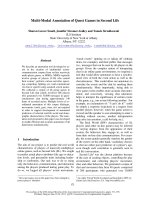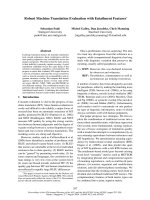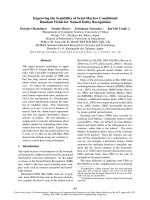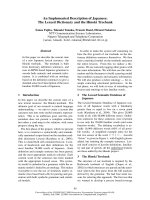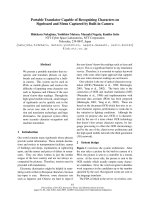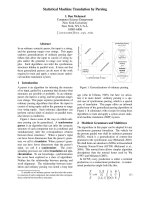Báo cáo khoa học: "Improving Machine Translation of Null Subjects in Italian and Spanish" pot
Bạn đang xem bản rút gọn của tài liệu. Xem và tải ngay bản đầy đủ của tài liệu tại đây (124.17 KB, 9 trang )
Proceedings of the EACL 2012 Student Research Workshop, pages 81–89,
Avignon, France, 26 April 2012.
c
2012 Association for Computational Linguistics
Improving Machine Translation of Null Subjects in Italian and Spanish
Lorenza Russo, Sharid Lo
´
aiciga, Asheesh Gulati
Language Technology Laboratory (LATL)
Department of Linguistics – University of Geneva
2, rue de Candolle – CH-1211 Geneva 4 – Switzerland
{lorenza.russo, sharid.loaiciga, asheesh.gulati}@unige.ch
Abstract
Null subjects are non overtly expressed
subject pronouns found in pro-drop lan-
guages such as Italian and Spanish. In
this study we quantify and compare the oc-
currence of this phenomenon in these two
languages. Next, we evaluate null sub-
jects’ translation into French, a “non pro-
drop” language. We use the Europarl cor-
pus to evaluate two MT systems on their
performance regarding null subject trans-
lation: Its-2, a rule-based system devel-
oped at LATL, and a statistical system
built using the Moses toolkit. Then we
add a rule-based preprocessor and a sta-
tistical post-editor to the Its-2 translation
pipeline. A second evaluation of the im-
proved Its-2 system shows an average in-
crease of 15.46% in correct pro-drop trans-
lations for Italian-French and 12.80% for
Spanish-French.
1 Introduction
Romance languages are characterized by some
morphological and syntactical similarities. Ital-
ian and Spanish, the two languages we are inter-
ested in here, share the null subject parameter,
also called the pro-drop parameter, among other
characteristics. The null subject parameter refers
to whether the subject of a sentence is overtly ex-
pressed or not (Haegeman, 1994). In other words,
due to their rich morphology, Italian and Span-
ish allow non lexically-realized subject pronouns
(also called null subjects, zero pronouns or pro-
drop).
1
From a monolingual point of view, regarding
Spanish, previous work by Ferr
´
andez and Peral
1
Henceforth, the terms will be used indiscriminately.
(2000) has shown that 46% of verbs in their test
corpus had their subjects omitted. Continuation
of this work by Rello and Ilisei (2009) has found
that in a corpus of 2,606 sentences, there were
1,042 sentences without overtly expressed pro-
nouns, which represents an average of 0.54 null
subjects per sentence. As for Italian, many anal-
yses are available from a descriptive and theoret-
ical perspective (Rizzi, 1986; Cardinaletti, 1994,
among others), but to the best of our knowledge,
there are no corpus studies about the extent this
phenomenon has.
2
Moreover, althought null elements have been
largely treated within the context of Anaphora
Resolution (AR) (Mitkov, 2002; Le Nagard and
Koehn, 2010), the problem of translating from
and into a pro-drop language has only been dealt
with indirectly within the specific context of MT,
as Gojun (2010) points out.
We address three goals in this paper: i) to com-
pare the occurrence of a same syntactic feature in
Italian and Spanish, ii) to evaluate the translation
of null subjects into French, that is, a “non pro-
drop” language; and, iii) to improve the transla-
tion of null subjects in a rule-based MT system.
Next sections follow the above scheme.
2 Null subjects in source corpora
We worked with the Europarl corpus (Koehn,
2005) in order to have a parallel comparative cor-
pus for Italian and Spanish. From this corpus,
we manually analyzed 1,000 sentences in both
languages. From these 1,000 sentences (26,757
words for Italian, 27,971 words for Spanish), we
identified 3,422 verbs for Italian and 3,184 for
2
Poesio et al. (2004) and Rodr
´
ıguez et al. (2010), for in-
stance, focused on anaphora and deixis.
81
Spanish. We then counted the occurrences of
verbs with pro-drop and classified them in two
categories: personal pro-drop
3
and impersonal
pro-drop
4
, obtaining a total amount of 1,041 pro-
drop in Italian and 1,312 in Spanish. Table 1
shows the results in percentage terms.
Total Pers. Impers. Total
Verbs pro-
drop
pro-
drop
pro-
drop
IT 3,422 18.41% 12.01% 30.42%
ES 3,182 23.33% 17.84% 41.17%
Table 1: Results obtained in the detection of pro-drop.
Results show a higher rate of pro-drop in Span-
ish (10.75%). It has 4.92% more personal pro-
drop and 5.83% more impersonal pro-drop than
Italian. The contrast of personal pro-drop is due to
a syntactic difference between the two languages.
In Spanish, sentences like (1a.) make use of two
pro-drop pronouns while the same syntactic struc-
ture uses a pro-drop pronoun and an infinitive
clause in Italian (1b.), hence, the presence of more
personal pro-drop in Spanish.
(1) a. ES
pro
le pido (1.sg) que
pro
inter-
venga (3.sg) con el prestigio de su
cargo.
b. IT
pro
le chiedo (1.sg) di intervenire
(inf.) con il prestigio della sua carica.
I ask you to intervene with the pres-
tige of your position.
The difference of impersonal pro-drop, on the
other hand, is due to the Spanish use of an im-
personal construction (2a.) with the “se” parti-
cle. Spanish follows the schema “se + finite verb
+ non-finite verb”; Italian follows the schema “fi-
nite verb + essere (to be) + past participle” (2b.).
We considered this construction formed by one
more verb in Italian than in Spanish as shown in
examples (2a.) and (2b.). This also explains the
difference in the total amount of verbs (Table 1).
(2) a. ES Se podr
´
a corregir.
b. IT Potr
`
a essere modificato.
It can be modified.
3
Finite verbs with genuinely referential subjects (i.e. I,
you, s/he, we, they).
4
Finite verbs with non-referential subjects (i.e. it).
We found a total number of non-expressed pro-
nouns in our corpus comparable to those obtained
by Rodr
´
ıguez et al. (2010) on the Live Memo-
ries corpus for Italian and by Recasens and Mart
´
ı
(2010) on the Spanish AnCora-Co corpus (Table
2). Note that in both of these studies, they were
interested in co-reference links, hence they did
not annotate impersonal pronouns, claiming they
are rare. On the other hand, we took all the pro-
drop pronouns into account, including impersonal
ones.
Corpus Language Result
Our corpus IT 3.89%
Live Memories IT 4.5%
Our corpus ES 4.69%
AnCora-Co ES 6.36%
Table 2: Null-subjects in our corpus compared to Live
Memories and AnCora-Co corpora. Percentages are
calculated with respect to the total number of words.
3 Baseline machine translation of null
subjects
The 1,000 sentences of our corpus were trans-
lated from both languages into French (IT→FR;
ES→FR) in order to assess if personal pro-drop
and impersonal pro-drop were correctly identi-
fied and translated. We tested two systems: Its-2
(Wehrli et al., 2009), a rule-based MT system de-
veloped at the LATL; and a statistical system built
using the Moses toolkit out of the box (Koehn et
al., 2007). The latter was trained on 55,000 sen-
tence pairs from the Europarl corpus and tuned on
2,000 additional sentence pairs, and includes a 3-
gram language model.
Tables 3 and 4 show percentages of correct, in-
correct and missing translations of personal and
impersonal null subjects calculated on the basis of
the number of personal and impersonal pro-drop
found in the corpus.
We considered the translation correct when the
null pronoun is translated by an overt pronoun
with the correct gender, person and number fea-
tures in French; otherwise, we considered it in-
correct. Missing translation refers to cases where
the null pronoun is not generated at all in the tar-
get language.
We chose these criteria because they allow us
to evaluate the single phenomenon of null subject
82
Its-2
Pair Pro-drop Correct Incorrect Missing
personal 66.34% 3.49% 30.15%
IT→FR impersonal 16.78% 18.97% 64.23%
average 46.78% 9.6% 43.61%
personal 55.79% 3.50% 40.70%
ES→FR impersonal 29.29% 11.40% 59.29%
average 44.28% 6.93% 48.78%
Table 3: Percentages of correct, incorrect and missing translation of zero-pronouns obtained by Its-2. Average is
calculated on the basis of total pro-drop in corpus.
Moses
Pair Pro-drop Correct Incorrect Missing
personal 71.59% 1.11% 27.30%
IT→FR impersonal 44.76% 11.43% 43.79%
average 61% 5.18% 33.81%
personal 72.64% 2.02% 25.34%
ES→FR impersonal 54.56% 2.45% 42.98%
average 64.78% 2.21% 33%
Table 4: Percentages of correct, incorrect and missing translation of zero-pronouns obtained by Moses. Average
is calculated on the basis of total pro-drop in corpus.
translation. BLEU and similar MT metrics com-
pute scores over a text as a whole. For the same
reason, human evaluation metrics based on ade-
quacy and fluency were not suitable either (Koehn
and Monz, 2006).
Moses generally outperforms Its-2 (Tables 3
and 4). Results for the two systems demon-
strate that instances of personal pro-drop are bet-
ter translated than impersonal pro-drop for the
two languages. Since rates of missing pronouns
translations are considerable, especially for Its-2,
results also indicate that both systems have prob-
lems resolving non-expressed pronouns for their
generation in French. A detailed description for
each system follows.
3.1 Results – Its-2
Its-2 obtains better results for IT→FR personal
pro-drop (66.34%) than for ES→FR (55.79%),
but worse for impersonal pro-drop translation
(16.78% and 29.29% respectively, Table 3).
For IT→FR translation in particular, Its-2 usu-
ally translates an Italian personal pro-drop with
an overt pronoun of incorrect gender in French.
In fact, it tends to translate a female personal pro-
drop with a masculine overt pronoun. This prob-
lem is closely related with that of AR: as the sys-
tem does not have any module for AR, it cannot
detect the gender of the antecedent, rendering the
correct translation infeasible.
The number of correct translation of imper-
sonal pro-drop is very low for both pairs. ES→FR
reached 29.29%, while IT→FR only 16.78% (Ta-
ble 3). The reason for these percentages is a reg-
ular mistranslation or a missing translation. As
for the mistranslation, in the case of Spanish,
Its-2 translates the “se” pronoun in impersonal
sentences by the French sequence qui est-ce que
(who) (3). We attribute this behaviour to a lack of
generation rules.
(3) ES Por consiguiente, mi grupo so-
licita que se suprima este punto del
d
´
ıa.
FR Par cons
´
equent, mon groupe sol-
licite qu’on supprime ce point de
l’agenda.
ITS-2 * Par cons
´
equent, mon groupe
sollicite qui est-ce que supprime ce
point du jour.
Therefore, my group ask to delete this
point from the agenda.
83
With respects to missing pronouns in the tar-
get language (Table 3), percentages are quite high
in both translation pairs (43.61% and 48.78% av-
erage missing pronouns respectively), especially
with impersonal pro-drop. Let us take the exem-
ple of ES→FR translation (59.29% missing pro-
nouns): Its-2 never generates the French expletive
pronouns “ce, c’, c¸a” (it) (4a.). For IT→FR trans-
lation (64.23% missing pronouns), it almost never
generates the French pronoun “il” (it) for the im-
personal 3rd person pro-drop pronoun in Italian
(4b.).
However, if the system generates the pronoun,
it is likely to be a first or a second person singular
pronoun (“je, tu” – I, you) in French, increasing
then the percentages of incorrectly translated im-
personal pro-drop.
(4) a. ES No es pedir demasiado.
FR Ce n’est pas trop demander.
ITS-2 * Pas est demander trop.
It is not too much to ask.
b. IT
`
E vero che [. . . ].
FR Il est vrai que [. . . ].
ITS-2 * Vrai que [. . . ].
It is true that [. . . ].
3.2 Results – Moses
Moses produces the highest percentage of cor-
rect translations for both personal and impersonal
pro-drop, particularly in ES→FR (72.64% and
54.56% respectively, Table 4).
When translating personal pro-drop from Ital-
ian, sometimes the system generates infinitive
forms instead of finite verbs (5).
(5) IT Naturalmente accettiamo questo
emendamento.
FR Bien s
ˆ
ur, nous acceptons cet
amendement.
MOSES Bien s
ˆ
ur accepter cet
amendement.
Of course, we accept this amend-
ment.
When translating impersonal pro-drop from
Italian, it performs worse (44.76%) because it
tends not to generate the expletive pronoun (6).
Furthermore, for both source languages, Moses
translates the impersonal pro-drop usually corre-
(6) IT Vorrei, come mi
`
e stato chiesto da
alcuni colleghi, osservare un minuto
di silenzio.
FR J’aimerais, comme il m’a
´
et
´
e de-
mand
´
e par certains coll
`
egues, ob-
server une minute de silence.
MOSES J’aimerais, comme m’a
´
et
´
e
demand
´
e par certains coll
`
egues, ob-
server une minute de silence.
I would like, as some collegues asked
me, to observe a minute of silence.
sponding to French pronoun “on” as the first plu-
ral personal pronoun (“nous” – we) (7a. and 7b.).
(7) a. IT Io credo che si debba dare la
precedenza alla sicurezza.
FR Je crois qu’on doit donner la pri-
orit
´
e
`
a la s
´
ecurit
´
e.
MOSES Je crois que nous devons
donner la priorit
´
e
`
a la s
´
ecurit
´
e.
I think that priority should be given
to the safety.
b. ES Como han demostrado los even-
tos recientes, queda mucho por hacer
sobre este tema.
FR Comme l’ont montr
´
e les
´
ev
´
enements r
´
ecents, on a encore
beaucoup
`
a faire sur ce th
`
eme.
MOSES Comme l’ont montr
´
e les
´
ev
´
enements r
´
ecents, nous avons en-
core beaucoup
`
a faire sur ce th
`
eme.
As it has been shown by recent
events, there is much left to do on this
subject.
4 Its-2 improvements
On the basis of this first evaluation, we tried to im-
prove Its-2 pronoun generation when translating
from Italian and Spanish. Two new components
were added to the translation pipeline: a rule-
based preprocessor, and a statistical post-editor.
This section presents them in detail, along with
the resources they rely on.
4.1 Rule-based preprocessing
Preprocessing of input data is a very common task
in natural language processing. Statistical sys-
tems often benefit from linguistic preprocessing
84
to deal with rich morphology and long distance re-
ordering issues (Sadat and Habash, 2006; Habash,
2007). In our case, the idea behind this first com-
ponent is to help the translation process of a rule-
based system by reducing the amount of zero pro-
nouns in the source document
5
, ensuring that sub-
ject pronouns get properly transferred to the target
language.
In order to assess the effect of this approach, we
implemented a rule-based preprocessor taking as
input a document in Italian or Spanish and return-
ing as output the same document with dropped
subject pronouns restored. It relies on two re-
sources: a list of personal and impersonal verbs,
and a part-of-speech tagging of the source docu-
ment. We first present these two resources before
describing the approach in more detail.
List of personal and impersonal verbs
This list simply contains surface forms of
verbs. For our experiment, these forms were
extracted from a subset of the Europarl corpus,
where pro-drop verbs were manually annotated
as taking a personal pronoun or an impersonal
pronoun. This limits the coverage, but ensures
domain-specific verb usage.
Part-of-speech tagging of the source document
Its-2, being a transfer-based system, relies on
a parser to construct the syntactic structure of the
source language and, from there, it transfers the
syntactic structure onto the target language. Its-
2 uses Fips (Wehrli, 2007), a multilingual parser
also developed at LATL. Apart from the projec-
tion of syntactic structures, Fips produces part-of-
speech tagging.
Outline of the approach
These are the steps followed by the preproces-
sor:
1. Read a part-of-speech tagged sentence.
2. Whenever a verb with no subject is encoun-
tered, check if it is a personal verb or an im-
personal verb.
5
In Italian and Spanish, even if a native speaker would
not use subject pronouns in a given sentence, the same sen-
tence with overtly expressed subject pronouns is grammati-
cal. There might be a pragmatic difference, as pronouns are
used in these languages when emphasis or contrast is desired
(Haegeman, 1994).
3. If it is a personal verb, generate the appropri-
ate pronoun before the verb (the masculine
form is generated for the third person); if it
is an impersonal verb, do not generate any
pronoun.
4. Check the sentence for reordering according
to syntactic rules of the target language (e.g.
move the generated pronoun before a pro-
clitic already preceding the verb).
An example of preprocessed sentences is given
in Figure 1.
4.2 Statistical post-editing
Since the work of Simard et al. (2007a), statisti-
cal post-editing (SPE) has become a very popular
technique in the domain of hybrid MT. The idea
is to train a statistical phrase-based system in or-
der to improve the output of a rule-based system.
The statistical post-editing component is trained
on a corpus comprising machine translated sen-
tences on the source side (translations produced
by the underlying rule-based system), and their
corresponding reference translations on the target
side. In a sense, SPE “translates” from imperfect
target language to target language. Both quantita-
tive and qualitative evaluations have shown that
SPE can achieve significant improvements over
the output of the underlying rule-based system
(Simard et al., 2007b; Schwenk et al., 2009).
We decided to incorporate a post-editing com-
ponent in order to assess if this approach can
specifically address the issue of dropped subject
pronouns. We first present the training corpus be-
fore describing the approach in more detail.
Training corpus
To train the translation model, we translated a
subset of the Europarl corpus using Its-2. The
translations were then aligned with correspond-
ing reference translations, resulting in a paral-
lel corpus for each language pair, composed of
976 sentences for IT→FR and 1,005 sentences
for ES→FR. We opted for machine translations
also on the target side, rather than human refer-
ence translations, in order to ascertain if a paral-
lel corpus produced in such a way, with signif-
icantly lesser cost and time requirements, could
be an effective alternative for specific natural lan-
guage processing tasks.
85
Source in Italian
pro
La ringrazio, onorevole Segni,
pro
lo far
`
o volentieri.
Preprocessed Io la ringrazio , onorevole Segni , io lo far
`
o volentieri .
I thank you, Mr. Segni, I will do it willingly.
Source in Spanish Todo ello, de conformidad con los principios que
pro
siempre hemos apoyado.
Preprocessed Todo ello, de conformidad con los principios que nosotros siempre hemos
apoyado.
All this, according to the principles we have always supported.
Figure 1: Output of the preprocessor: the pronoun in the first sentence is generated before the proclitic lo, and
the pronoun in the second sentence is generated before the adverb “siempre” (always).
We reused the language model trained for the
Moses experiment of Section 3.
Outline of the approach
We trained the SPE component using the
Moses toolkit out of the box. With this setup, the
final translation in French of a source sentence in
Italian or Spanish can be obtained in two simple
steps:
1. Translate a sentence using Its-2.
2. Give the translated sentence as input to the
SPE component; the output of the SPE com-
ponent is the final translation.
An example of post-edited translations is given
in Figure 2.
4.3 Combination of preprocessing and
post-editing
The two components described in the previous
sections can be used separately, or combined to-
gether as the first and last elements of the same
translation pipeline. With respect to the gen-
eration of pronouns, error analysis showed that
the setup producing the best translations was in-
deed the combination of preprocessing and post-
editing, which was therefore used in the full post-
evaluation described in the next section. The ex-
ample in Figure 3 illustrates progressive improve-
ments (with respect to the generation of pronouns)
achieved by using preprocessing and post-editing
over the baseline Its-2 translation.
5 Post-evaluation
After adding the two components, we manually
re-evaluated the translations of the same 1,000
sentences. Table 5 show percentages of correct,
incorrect and missing translation of null subjects
in a comparative way: the first columns show per-
centages obtained by the baseline Its-2 system
6
while the second columns show percentages ob-
tained by the improved system.
Results show higher percentages of correct pro-
drop translation for both language pairs, with
an average increase of 15.46% for IT→FR, and
12.80% for ES→FR. Specifically, percentages
of personal pro-drop translation for both pairs
increased almost the same rate: 13.18% for
IT→FR; 13.34% for ES→FR. It was not the case
for impersonal pro-drop, where rates of the first
pair augmented (18.98%), while the latter de-
creased (12.11%).
We explain this behaviour to a particular dif-
ficulty encountered when translating from Span-
ish, a language that largely prefers subjunctive
mood clauses to other structures such as infinitive
clauses. The problem arises because subjunctive
tenses have a less distinctive morphology, with the
same conjugation for the first and third person sin-
gular (9).
(9) ES
pro
le pido (1.sg) que
pro
estudie
(3.sg) un borrador de carta.
FR Je vous demande d’
´
etudier un
brouillon de lettre.
ITS-2 *Je (1.sg) demande que
j’
´
etudie (1.sg) un brouillon de charte.
I ask you to study a draft letter.
As a consequence of the improvement of per-
sonal pro-drop, only incorrect impersonal pro-
drop translations decreased (Table 5). Indeed,
if we consider personal pro-drop translation, we
think that by means of restoring the pronouns for
finite verbs, we also amplified the issue of AR.
For instance, Italian uses the third singular person
6
These percentages have already been discussed in sec-
tion 3 and, in particular, in Table 3.
86
Its-2 translation Vous invite
`
a voter
`
a faveur de l’amendement approuv
´
e
`
a l’unanimit
´
e [. . . ].
Post-edited Je vous invite
`
a voter en faveur de l’amendement approuv
´
e
`
a l’ unanimit
´
e [. . . ].
I invite you to vote in favour of the amendment unanimously approved [. . . ].
Its-2 translation Je madame Pr
´
esidente, voudrais r
´
eclamer l’attention sur un cas [. . . ].
Post-edited Madame la Pr
´
esidente, je voudrais r
´
eclamer l’attention sur un cas [. . . ].
Madam President, I would like to draw the attention on a case [. . . ].
Figure 2: Output of the post-editor: the pronoun in the first sentence is restored, and the pronoun in the second
sentence is moved to the correct position.
Source in Italian
pro
E’ la prima volta che
pro
intervengo in Plenaria e
pro
devo ammettere di
essere molto emozionato [. . . ].
Preprocessed E’ la prima volta che io intervengo in Plenaria e io devo ammettere di essere
molto emozionato [. . . ].
Baseline Qu’est la premi
`
ere fois qu’intervient dans *Plenaria et admettre de m’est
beaucoup
´
emus [. . . ].
Translation
-after preprocessing Est la premi
`
ere fois que j’interviens dans *Plenaria et j’admettre d’est beau-
coup
´
emus [. . . ].
-with post-editing Qu ’est la premi
`
ere fois qu’ intervient en pl
´
eni
`
ere ont et admettre de s ’est
tr
`
es
´
emus [. . . ].
-using both C ’est la premi
`
ere fois que j’ interviens en pl
´
eni
`
ere ont et j ’admettre d’ est
tr
`
es
´
emus [. . . ].
It is the first time that I speak in the Plenary session and I admit to being
[. . . ].
Figure 3: Comparison of translation outputs: preprocessing leads to a better analysis of the sentence by Fips,
as suggested by the presence of the pronouns “j’” (I), absent in the baseline translation, and post-editing further
restores successfully the missing impersonal pronoun “C’” (It), whereas post-editing without preprocessing has
no effect on pronoun generation.
Baseline Its-2 Improved Its-2
Pair Pro-drop Correct Incorrect Missing Correct Incorrect Missing
personal 66.34% 3.49% 30.15% 79.52% 5.87% 14.60%
IT→FR impersonal 16.78% 18.97% 64.23% 35.76% 13.13% 51.09%
average 46.78% 9.6% 43.61% 62.24% 8.73% 29%
personal 55.79% 3.50% 40.70% 69.13% 7.81% 23.04%
ES→FR impersonal 29.29% 11.40% 59.29% 41.40% 8.07% 50.52%
average 44.28% 6.93% 48.78% 57.08% 7.92% 34.98%
Table 5: Percentages of correct, incorrect and missing translation of zero-pronouns. Results obtained by im-
proved Its-2. Average is calculated on the basis of total pro-drop in corpus.
(“lei”) as a form of polite treatment, while French
uses the second plural person (“vous”); however,
Its-2 translates a restored pronoun for a finite verb
in the third singular person as a finite verb in the
third singular person in French too (8).
Gender discrepancies are an AR issue as well.
For IT→FR, the problem of a female personal
pro-drop translated by a masculine overt pronoun
in French still remains.
Finally, rates of missing pronouns also de-
creased. In this case, improvements are signif-
icant: we obtained a gain of 14.61% for the
IT→FR pair and 13.8% for the ES→FR pair.
Specifically, we obtained better improvements
for personal pro-drop than for impersonal pro-
drop. For the latter we think that rates decreased
87
(8) IT Signora Presidente, mi permetta di
parlare.
FR Madame la Pr
´
esidente,
permettez-moi de parler.
ITS-2 Madame la Pr
´
esidente,
permet-moi de parler.
Madam President, let me speak.
thanks only to the post-editing phase. Indeed, as
both Italian and Spanish do not have any pos-
sible overt pronoun to be restored in the pre-
processing phase, any improvement responds to
changes made by the post-editor. On the other
hand, improvements obtained for personal pro-
drop translation confirm that the combination of
the pre-processing and the post-editing together
can be very advantageous, as already discussed in
section 4.3.
6 Future work
As already mentioned, we have not found the so-
lution to some problems yet.
First of all, we would like to include an AR
module in our system. As it is a rule-base sys-
tem, some problems as the subject pronoun mis-
translation in subordinated sentences can be fixed
by means of more specific rules and heuristics.
Besides, an approach based on binding theory
(B
¨
uring, 2005) could be effective as deep syntac-
tic information is available, even though limited.
For example, binding theory does not contain any
formalization on gender, reason why a specific
statistical component could be a more ideal op-
tion in order to tackle aspects such as mascu-
line/feminine pronouns.
Secondly, an overt pronoun cannot be restored
from a finite impersonal verb without making the
sentence ungrammatical; therefore, our approach
is not useful for treating impersonal sentences. As
a consequence, we think that an annotation of the
empty category, as done by Chung and Gildea
(2010), could provide better results.
Also, in order to correctly render the meaning
of a preprocessed sentence, we plan to mark re-
stored subject pronouns in such a way that the
information about their absence/presence in the
original text is preserved as a feature in parsing
and translation.
Finally, we would like to use a larger corpus to
train the SPE component and compare the effects
of utilizing machine translations on the target side
versus human reference translations. Besides, we
would like to further explore variations on the
plain SPE technique, for example, by injecting
Moses translation of sentences being translated
into the phrase-table of the post-editor (Chen and
Eisele, 2010).
7 Conclusion
In this paper we measured and compared the oc-
currence of one syntactic feature – the null sub-
ject parameter – in Italian and Spanish. We also
evaluated its translation into a “non pro-drop” lan-
guage, that is, French, obtaining better results for
personal pro-drop than for impersonal pro-drop,
for both Its-2 and Moses, the two MT systems we
tested.
We then improved the rule-based system us-
ing a rule-based preprocessor to restore pro-drop
as overt pronouns and a statistical post-editor to
correct the translation. Results obtained from the
second evaluation showed an improvement in the
translation of both sorts of pronouns. In particu-
lar, the system now generates more pronouns in
French than before, confirming the advantage of
using a combination of preprocessing and post-
editing with rule-based machine translation.
Acknowledgments
This work has been supported in part by the Swiss
National Science Foundation (grant No 100015-
130634).
References
Daniel B
¨
uring. 2005. Binding Theory. Cambridge
Textbooks in Linguistics.
Anna Cardinaletti. 1994. Subject Position. GenGenP,
2(1):64–78.
Yu Chen and Andreas Eisele. 2010. Hierarchical
Hybrid Translation between English and German.
In Proceedings of the 14th Annual Conference of
the European Association for Machine Translation,
pages 90–97.
Tagyoung Chung and Daniel Gildea. 2010. Effects
of Empty Categories on Machine Translation. In
Proceedings of the 2010 Conference on Empirical
Methods in Natural Language Processing, EMNLP
’10, pages 636–645.
Antonio Ferr
´
andez and Jes
´
us Peral. 2000. A Com-
putational Approach to Zero-pronouns in Spanish.
In Proceedings of the 38th Annual Meeting of the
88
Association for Computational Linguistics, pages
166–172.
Anita Gojun. 2010. Null Subjects in Statistical Ma-
chine Translation: A Case Study on Aligning En-
glish and Italian Verb Phrases with Pronominal
subjects. Diplomarbeit, Institut f
¨
ur Maschinelle
Sprachverarbeitung, University of Stuttgart.
Nizar Habash. 2007. Syntactic Preprocessing for Sta-
tistical Machine Translation. In Proceedings of Ma-
chine Translation Summit XI, pages 215–222.
Liliane Haegeman. 1994. Introduction to Government
and Binding Theory. Blackwell Publishers.
Philipp Koehn and Christof Monz. 2006. Manual
and Automatic Evaluation of Machine Translation
between European Languages. In Proceedings on
the HTL-NAACL Workshop on Statistical Machine
Translation, pages 102–121. Association for Com-
putational Linguistics.
Philipp Koehn, Hieu Hoang, Alexandra Birch, Chris
Callison-Burch, Marcello Federico, Nicola Bertoli,
Brooke Cowan, Wade Shen, Christine Moran,
Richard Zens, Christopher J. Dyer, Ond
ˇ
rej Bojar,
Alexandra Constantin, and Evan Herbst. 2007.
Moses: Open Source Toolkit for Statistical Ma-
chine Translation. In Proceedings of the 45th An-
nual Meeting of the Association for Computational
Linguistics Companion Volume Proceedings of the
Demo and Poster Sessions, pages 177–180. Associ-
ation for Computational Linguistics.
Philipp Koehn. 2005. Europarl: A Parallel Corpus for
Statistical Machine Translation. In Proceedings of
the 10th Machine Translation Summit (MT Summit
X).
Ronan Le Nagard and Philipp Koehn. 2010. Aiding
Pronoun Translation with Co-Reference Resolution.
In Proceedings of the Joint 5th Workshop on Statis-
tical Machine Translation, pages 258–267.
Ruslan Mitkov. 2002. Anaphora Resolution. Long-
man.
Massimo Poesio, Rodolfo Delmonte, Antonella Bris-
tot, Luminita Chiran, and Sara Ronelli. 2004. The
VENEX corpus of anaphora and deixis in spoken
and written Italian. In Manuscript.
Marta Recasens and M. Ant
`
onia Mart
´
ı. 2010.
AnCora-CO: Coreferentially Annotated Corpora
for Spanish and Catalan. Language Resources and
Evaluation, 44(4):315–345.
Luz Rello and Iustina Ilisei. 2009. A Rule-Based
Approach to the Identification of Spanish Zero Pro-
nouns. In Proceedings of Student Research Work-
shop, RANLP, pages 60–65.
Luigi Rizzi. 1986. Null Objects in Italian and the
Theory of pro. Linguistic Inquiry, 17(3):501–557.
Kepa J. Rodr
´
ıguez, Francesca Delogu, Yannick Vers-
ley, Egon W. Stemle, and Massimo Poesio. 2010.
Anaphoric Annotation of Wikipedia and Blogs
in the Live Memories Corpus. In Proceedings
of the Seventh International Conference on Lan-
guage Resources and Evaluation (LREC), Valletta,
Malta. European Language Resources Association
(ELRA).
Fatiha Sadat and Nizar Habash. 2006. Combination of
Arabic Preprocessing Schemes for Statistical Ma-
chine Translation. In Proceedings of the 21st Inter-
national Conference on Computational Linguistics
and 44th Annual Meeting of the ACL, pages 1–8.
Holger Schwenk, Sadaf Abdul-Rauf, Lo
¨
ıc Barrault,
and Jean Senellart. 2009. SMT and SPE Machine
Translation Systems for WMT’09. In Proceedings
of the 4th Workshop on Statistical Machine Trans-
lation, pages 130–134.
Michel Simard, Cyril Goutte, and Pierre Isabelle.
2007a. Statistical Phrase-based Post-editing. In
Proceedings of NAACL HLT 2007, pages 508–515.
Michel Simard, Nicola Ueffing, Pierre Isabelle, and
Roland Kuhn. 2007b. Rule-based Translation With
Statistical Phrase-based Post-editing. In Proceed-
ings of the 2nd Workshop on Statistical Machine
Translation, pages 203–206, June.
Eric Wehrli, Luka Nerima, and Yves Scherrer. 2009.
Deep Linguistic Multilingual Translation and Bilin-
gual Dictionaries. In Proceedings of the Fourth
Workshop on Statistical Machine Translation, pages
90–94.
Eric Wehrli. 2007. Fips, a “Deep” Linguistic Multi-
lingual Parser. In Proceedings of the Workshop on
Deep Linguistic Processing, pages 120–127. Asso-
ciation for Computational Linguistics.
89


